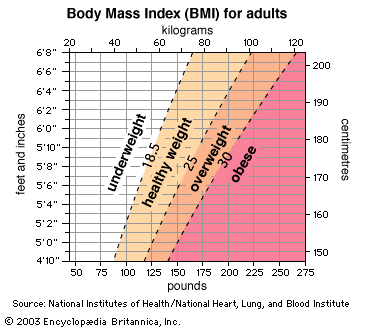How BMI is becoming an inadequate measure for health
Syllabus:
GS 3:
- Issues related to Health.
- Science and its application in everyday life
Focus:
The Body Mass Index (BMI) is being questioned for its effectiveness as a health metric, with the Body Roundness Index (BRI) emerging as a more accurate predictor of fat distribution and related health risks, particularly metabolic syndrome.
Overview of BMI’s Limitations
- Historical Use: BMI is widely used in health check-ups, but it lacks accuracy in predicting an individual’s overall health and fat distribution.
- Basic Formula: It calculates weight in relation to height, dividing body weight (kg) by height (m²), but doesn’t account for fat distribution or muscle mass.
- Ethnic Variations: BMI is less accurate for non-European populations, as fat distribution differs, leading to misclassification of health risks, especially for Asians.
- Athletic Misrepresentation: Individuals with high muscle mass, like athletes, may have high BMIs without being unhealthy, as BMI doesn’t differentiate muscle from fat.
- Modern Concerns: Increasing health experts challenge BMI’s ability to predict future health conditions, leading to exploration of more accurate indices like BRI.
Difference Between BMI and BRI
- BRI Formula: BRI incorporates waist circumference along with height, measuring body fat percentage more accurately compared to BMI’s simplistic weight-height ratio.
- Body Shape: BRI considers the roundness of a body, providing insights into fat distribution, particularly abdominal fat, a key risk factor for metabolic diseases.
- Fat Distribution: While BMI overlooks fat location, BRI highlights the dangers of visceral fat, especially in the abdomen, linked to diabetes and cardiovascular diseases.
- Health Scores: BRI assigns scores from 1 to 15, with extreme values indicating higher risk, making it more useful for identifying health concerns across populations.
- Metabolic Indicators: BRI better predicts risks like diabetes and heart disease by assessing both body shape and fat distribution, which BMI doesn’t address.
Visceral Fat and Health Risks
- Fat Location: The location of fat, particularly around internal organs, poses greater health risks than overall body fat, leading to issues like metabolic syndrome.
- Visceral Fat Impact: High levels of visceral fat around organs increase susceptibility to type 2 diabetes, hypertension, and cardiac diseases, especially in Indians.
- Genetic Predisposition: Asians, especially Indians, tend to accumulate fat in the abdomen, leading to insulin resistance and higher chances of developing diabetes.
- Misleading BMI: BMI may categorize individuals as healthy based on weight, ignoring dangerous fat accumulation in the abdomen, which contributes to chronic diseases.
- Waist-Height Ratio: Simple indicators like the waist-to-height ratio are becoming more reliable in assessing health risks compared to BMI alone.
Reliability of BRI as an Alternative
- Research Backing: Studies like JIPMER’s 2021 paper showed that BRI is a better predictor of metabolic syndrome compared to traditional BMI measurements.
- Predictive Power: BRI has been found to have higher predictive accuracy for health risks such as all-cause mortality, according to a 2021 cohort study of over 32,000 adults.
- Study Findings: Research shows BRI’s U-shaped association with mortality, where both the lowest and highest BRI groups face increased mortality risks.
- Measurement Errors: Human error in manually measuring waist circumference can impact BRI accuracy, highlighting challenges in self-measuring at home.
- Developing Data: While promising, BRI lacks extensive data compared to BMI, and further research is needed to cement its position as a reliable health measure.
Future of Health Measurement Indices:
- Ongoing Debate: The comparison between BMI and newer indices like BRI will continue, as experts refine tools to better measure health risks for diverse populations.
- Practical Use: Simple indices like waist-to-height ratios offer practical, reliable insights for people to monitor their health independently.
- Broader Metrics: Beyond BMI and BRI, incorporating other health metrics like biochemical profiles and physical activity levels provides a more holistic view of health.
- Public Awareness: As awareness grows about the limitations of BMI, the adoption of more accurate measures like BRI will likely increase among healthcare professionals.
- Population Health: More nuanced health assessments are essential for improving health outcomes, particularly for populations prone to metabolic and lifestyle diseases.
Way Forward:
- Adopt BRI: Healthcare professionals should incorporate BRI into routine check-ups, alongside BMI, to provide a more comprehensive understanding of body fat distribution and associated health risks.
- Public Awareness Campaigns: Initiatives should be launched to educate the public on the limitations of BMI and promote understanding of more reliable metrics like BRI and waist-height ratios.
- Ethnic-Specific Metrics: Develop tailored health indices for various ethnic groups, ensuring accurate assessments that account for genetic predispositions, such as abdominal fat accumulation in Asians.
- Improve Measurement Accuracy: Train healthcare professionals in accurate waist circumference measurement, and develop tools to reduce human error, improving the reliability of BRI assessments.
- Comprehensive Health Screening: Encourage the use of biochemical profiles, physical activity levels, and other metabolic indicators alongside BRI for a holistic approach to assessing individual health.
- Ongoing Research: Continue studying BRI and other novel health indices to validate their predictive accuracy for various health outcomes, contributing to more effective public health policies.
Conclusion:
BMI, while commonly used, is proving inadequate in assessing true health risks. BRI, by considering fat distribution, offers a more nuanced and accurate measure, potentially improving healthcare outcomes in diverse populations.
Source: The Hindu
Mains Practice Question:
“Discuss the limitations of Body Mass Index (BMI) as a health measure and explain how the Body Roundness Index (BRI) can offer a more accurate prediction of health risks.”
Associated Article:
https://universalinstitutions.com/may-all-be-free-of-illness/




